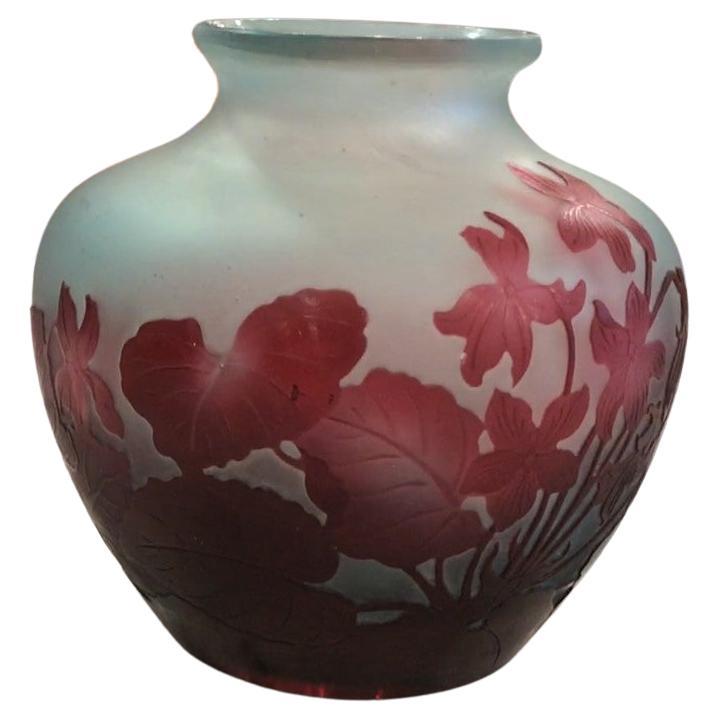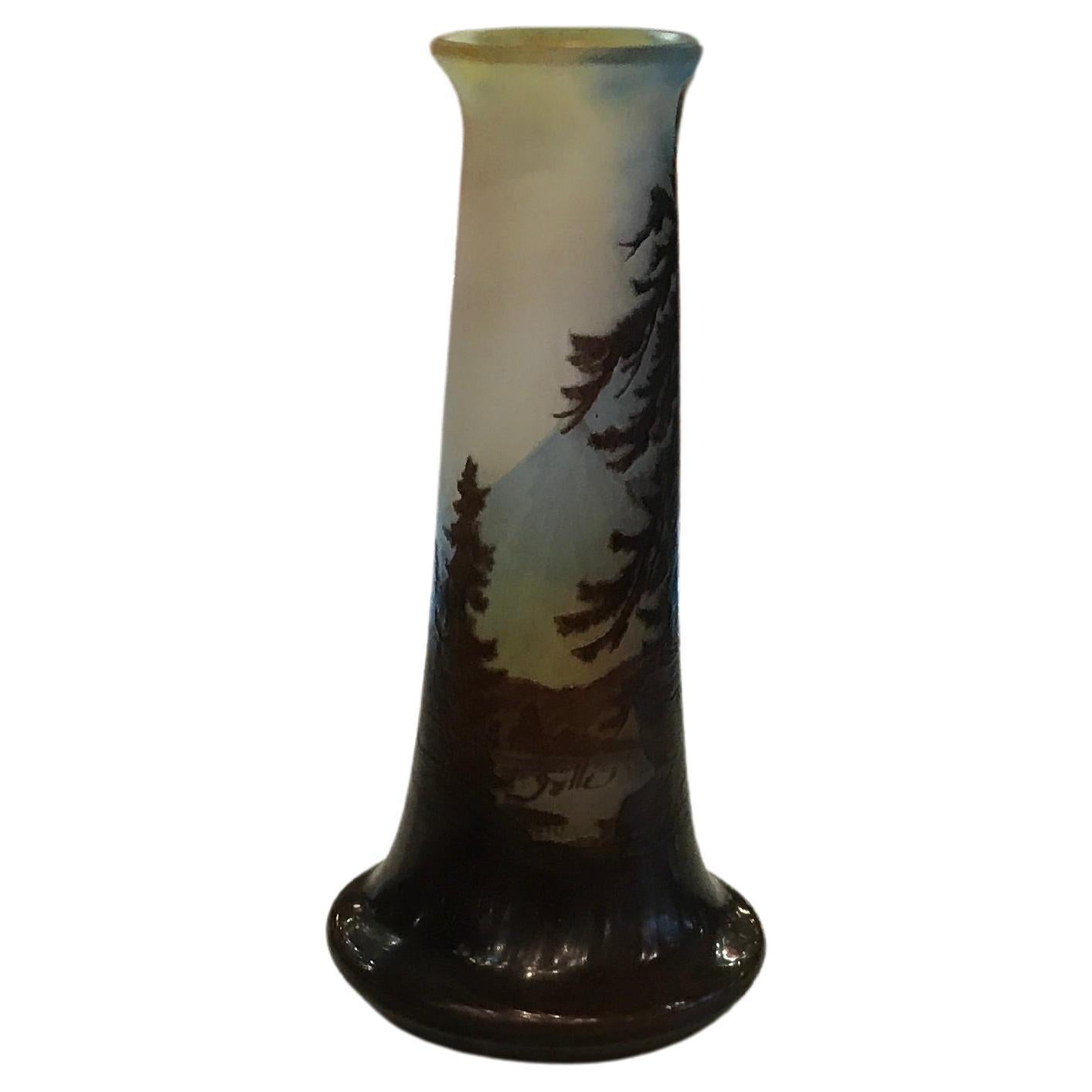Items Similar to Vase in glass souffle, Sign: Galle, Style: Jugendstil, Art Nouveau, Liberty
Video Loading
Want more images or videos?
Request additional images or videos from the seller
1 of 22
Vase in glass souffle, Sign: Galle, Style: Jugendstil, Art Nouveau, Liberty
About the Item
Sign: Galle
worked in stone
Gallé
World Famous for his innovative work in several areas of the decorative arts, including glass, furniture & ceramics, Emile Galle` (1846-1904) was born and died in the town of Nancy in Eastern France. In his teens, Galle` traveled widely and even fought in the war between France and Prussia. In London he was fascinated by the enameling techniques seen in the oriental collection of the Victoria & Albert Museum. It was here that he saw the original Portland cameo glass vase, which would have a great influence on his future artistic endeavors. He first learned the craft of ceramics by helping his father Charles run the family business, Galle`-Reinemer, a successful fine crystal and ceramics store. The ceramics were made in the nearby town of Saint Clement, producing fantasy Faience items during the period between 1864-1876. By this time Charles had retired, and the production of ceramics was transferred to Nancy. In 1885 Galle` had started his own ceramic production using local clays with the installation of a modernized kiln, and a new decorating shop. Galle’ had a three way deal between Burgun Schverer and Desire Christian who agreed to produced Galle`s first glass designs and sign them with Galle`s name in exchange for a ten year contract. This ten-year contract was not renewed when Galle` established his own glass studio in 1894. Galle` built his own manufacturing plant in Nancy and began creating his own designs from inception through production. Galle` personally created many of the designs, and he was known to actively make alterations and approve the designs of his talented team of designers and craftsmen he employed at the "Cristallerie D'Emile Galle`." Galle` died in 1904 from leukemia at the young age of 58. His widow continued to make Galle` glass designs in the factory until World War I in 1914. Pieces made from 1904 - 1914 are signed "Galle`" with a star added (note that after 1914 Galle` glass no longer used the star, thus the star only dates the period of 1904-1914). After World War I, Paul Perdrizet, Emile's son-in-law, began producing Galle` glass once again, even adding new designs and primarily making the multi-layer cameo glass in floral and landscape designs. Galle` cameo glass was both wheel cut and acid etched, both techniques which required fine craftsmanship to produce, and in which layers of multi-colored glass is progressively removed to create the designs. Galle` production ceased in 1936.
We have specialized in the sale of Art Deco and Art Nouveau and Vintage styles since 1982.If you have any questions we are at your disposal.
Pushing the button that reads 'View All From Seller'. And you can see more objects to the style for sale.
Why are there so many antiques in Argentina?
In the 1880 – 1940 there was a grate wave of immigration encouraged by the periods of war that were taking place.
1st World War took place between 1914 and 1918
2nd World War took place between 1939 and 1945
The immigrants options were New York or Buenos Aires. Tickets were cheap and in Buenos Aires they were welcomed with open arms, as it was a country where everything was still to be done.
Argentina was the country of new opportunities, labour was needed and religious freedom was assured, in many cases the of the family travel first until they were settled and then the rest of the family members join them.
In the immigrant museum “Ellis Island Immigrant Building” in New York you can se the promotional posters of the boats that would take them to a new life.
Between the years 1895 and 1896, Argentina had the highest DGP (gross domestic product) per capita in the world according to the Maddison Historical Statistics index, this situation arose due to the large amount of food being exported to European countries, which were at war.
The Argentinean ships left the port of Buenos Aires with food, but they returned with furniture, clothes and construction elements, (it´s common to see this the old buildings of the historic neighbourhood of San Telmo, the beams with the inscription “Made in England)”, as well as many markets that were built in Buenos Aires, such us the San Telmo Market, whose structure was brought by ship and afterwards assembled in 900 Defensa Street.
With the great influence of European immigrants living in the country, the children of the upper classes travelled to study in France, resulting in the inauguration of “La Maison Argentinienne”, on 27th of June 1928, in the international city of Paris, which hosted many Argentinians that were studying in Frace.
It´s the fourth house to be built after France, Canada and Belgium, being the first Spanish-speaking one. Still in place today (17 Bd Jourdan, 75014, Paris, France). Many of the children of these wealthy families who attended international art exhibitions, museums and art courses abroad, took a keen interest in the European style. This is why Buenos Aires was at the time referred as “The Paris of South America”.
Between the years 1890 and 1920 more than a hundred Palaces were built on Alvear Avenue the most exclusive avenue in Buenos Aires. Today some of these palaces have been transformed into museums, hotels and embassies.
In the year 1936, the Kavanagh building was inaugurated, it was the tallest reinforced concrete building in South America.
During 1994 the American Society of Civil Engineers distinguished it as an “international engineering milestone”, and it´s now considered a World Heritage of Modern Architecture.
At the time was common to hire foreign architects such as Le Corbusier, who visited Buenos Aires/Argentina in 1929 and in 1948 he drew up the blueprints for a house built in La Plata City (which was declared a World Heritage Site).
In 1947, the Hungarian architect Marcelo Breuer designed “Parador Ariston” in the seaside city of Mar del Plata. After an Argentinean student at Harvard University convinced him to come to Argentina. He worked on an urban development project in the Casa Amarilla, area of La Boca.
The Ukrainian architect, Vladimiro Acosta, arrives in Argentina in 1928 and worked as an architect until que moved to Brazil.
Antonio Bonet, a Spanish architect who worked with Le Corbusier in Paris, arrives in Argentina in 1937, where he carried out several architectural works and in 1938 designs the well-known BFK chair.
Andres Kálnay, of Hungarian origin, made around 120 architectural masterpieces, among which the former Munich brewery stands out, he even made the furniture’s design.
The German architect, Walter Gropius, director of the Bauhaus, lived in Argentina, where he wrote articles for “Sur” magazine and founded in Buenos Aires, an architectural firm with Franz Möller, who was also an architect, where he built two houses.
At the same time several famous designers decided to immigrate to Argentina, among them we can find the well-known French designer, Jean-Michel Frank, who arrived in the country in 1940 and also worked for the Rockefeller family.
Special pieces were made, which were sold exclusively in the country, such as the well-known German company “WMF”, who sold their products by catalogue, which were chosen by the ladies of High Society in the list of wedding gifts, as well as the pieces designed by Christofle.
The Swiss sculptor Alberto Giacometti, made special pieces for Argentinean mansions.
In 1904 the first Jansen branch outside Paris was established in Buenos Aires, as the Argentinean clientele demanded a large amount of furniture, from the end of the 19th century to the mid-20th century.
In 1970, the brand Rigolleau Argentina made pieces authorised by Lalique.
The brands Maple and Thompson also set up shop in the country.
The French plastic artist, Marcel Duchamp moved to Argentina in 1918-1919.
Glass signed Gallé, Charder, Leverre, Schneider, Muller and other French firms. They were bought in flower shops and were given to ladies with beautiful floral arrangements.
Some furniture manufacturers travelled to international fairs and bough the patterns to produce the furniture in Argentina, such as the furniture firm Englander and Bonta, who bought the patterns ins Italy.
It is worth mentioning that in Argentina we have the largest Community of Italians outside of Italy, as it is estimated that 70 percent of the inhabitants have at least one Italian descendant, followed by Spanish immigrants.
The most Important furniture stores in Argentina:
Comte is founded in 1934 (under the direct management of Jean Michel Frank in 1940).
Nordiska (Swedish company established in 1934).
Churba in 1960, a company that brought foreign designers to present their furniture in the country:
Denmark: (Arne Jacobsen, Finn Juhl, Bender Madsen, Ejner Larsen, Poul Kjaerholm, Hans Wegner)
Sweden: (Hans Agne Jakobsson, Gustavsberg)
United States: (Herman Miller)
Finland: (Lisa Johansson, Folke Arstrom, Tapio Wirkkala, Alvar Aalto, Timo Sarpaneva)
Swedish Factory: (Orrefors)
Italy: (Littala, Vico Magistretti, Emma Gismondi, Gae Aulenti, Angelo Mangiarotti, Elio Martinelli, Gianna Celada, Angelo Mangiarotti, Mario Bellini, Carlo Scarpa)
Finland: (Olivia Toikka)
Plata Lappas (Lappas Silver): a goldsmith shop founded in 1887 in Argentina by Alcibiades Lappas of Greek origin.
In 2019, in Argentina took place “the Art Deco world congress”, in which we participated as hosts invited by Geo Darder, founder of the Copperbridge – Foundation, in which prominent people from all over the world attended to learn about Art Deco in Argentina.
Argentina currently has more than 100 Art Deco buildings and another 90 Art Nouveau buildings throughout the city of Buenos Aires.
Argentina is a country that has not been involved in many wars, which is why it has been a refuge for works of art and antiques from different periods of time, unlike European countries. That is way many collectors, museums and antique dealers from all over the world visit it, you should not miss the opportunity to visit this great country.
Laura Guevara Kjuder, architect.
- Creator:Gallé (Designer)
- Dimensions:Height: 24 in (60.96 cm)Diameter: 16 in (40.64 cm)
- Style:Art Nouveau (Of the Period)
- Materials and Techniques:
- Place of Origin:
- Period:1900-1909
- Date of Manufacture:1905
- Condition:Wear consistent with age and use.
- Seller Location:Ciudad Autónoma Buenos Aires, AR
- Reference Number:
About the Seller
5.0
Vetted Seller
These experienced sellers undergo a comprehensive evaluation by our team of in-house experts.
Established in 1982
1stDibs seller since 2022
21 sales on 1stDibs
Typical response time: <1 hour
- ShippingRetrieving quote...Ships From: Ciudad Autónoma Buenos Aires, Argentina
- Return PolicyThis item cannot be returned.
More From This SellerView All
- Vase, Sign: Gallé, Style: Jugendstil, Art Nouveau, LibertyBy GalléLocated in Ciudad Autónoma Buenos Aires, CSign: Galle Gallé World Famous for his innovative work in several areas of the decorative arts, including glass, furniture & ceramics, Emile Galle` (1846-1904) was born and died in t...Category
Vintage 1920s French Art Nouveau Glass
MaterialsGlass
- Vase, Sign: Gallé, Style: Jugendstil, Art Nouveau, Liberty, 1905By GalléLocated in Ciudad Autónoma Buenos Aires, CSign: Galle Gallé World Famous for his innovative work in several areas of the decorative arts, including glass, furniture & ceramics, Emile Galle` (1846-1904) was born and died in t...Category
Antique Early 1900s French Art Nouveau Glass
MaterialsGlass
- Vase, Sign: Gallé, Style: Jugendstil, Art Nouveau, Liberty, 1900By GalléLocated in Ciudad Autónoma Buenos Aires, CSign: Galle Gallé World Famous for his innovative work in several areas of the decorative arts, including glass, furniture & ceramics, Emile Galle` (1846-1904) was born and died in t...Category
Vintage 1910s French Art Nouveau Glass
MaterialsGlass
- French Vase, Sign: Gallé, Style: Jugendstil, Art Nouveau, LibertyBy GalléLocated in Ciudad Autónoma Buenos Aires, CSign: Galle Gallé World Famous for his innovative work in several areas of the decorative arts, including glass, furniture & ceramics, Emile Galle` (1846-1904) was born and died in t...Category
Antique Early 1900s French Art Nouveau Glass
MaterialsGlass
- Vase, Sign: Gallé, Style: Jugendstil, Art Nouveau, Liberty, 1905By GalléLocated in Ciudad Autónoma Buenos Aires, CSign: Galle Gallé World Famous for his innovative work in several areas of the decorative arts, including glass, furniture & ceramics, Emile Galle` (1846-1904) was born and died in t...Category
Antique Early 1900s French Art Nouveau Glass
MaterialsGlass
- Vase, Sign: Gallé, Style: Jugendstil, Art Nouveau, Liberty, 1905By GalléLocated in Ciudad Autónoma Buenos Aires, CSign: Galle Gallé World Famous for his innovative work in several areas of the decorative arts, including glass, furniture & ceramics, Emile Galle` (1846-1904) was born and died in t...Category
Antique Early 1900s French Art Nouveau Glass
MaterialsGlass
You May Also Like
- Very Large Antique Signed Gallé French Art Nouveau Green Cameo Art Glass VaseBy GalléLocated in Philadelphia, PAA fine, very large scale antique French art glass vase. In green tones. With acid-cut back cameo grapes, grape leaves, & vines. Signe...Category
Early 20th Century French Art Nouveau Vases
MaterialsGlass, Art Glass
- Soliflore glass vase signed Gallé, Art Nouveau, FranceBy Emile GalléLocated in Paris, FRSmall soliflore vase in glass paste Signed Gallé, France Art Nouveau, early 20th century.Category
Early 20th Century French Art Nouveau Vases
MaterialsGlass
- Art Nouveau French Glass Decanter Set by Emile GalleBy Gallé, Galle Art Glass, Emile GalléLocated in Fort Lauderdale, FLA beautifully delicate French glass decanter set made by Emile Galle in the late 19th century, decorated in enamels with ribbons and flowers in a...Category
Antique 1860s French Art Nouveau Glass
MaterialsGlass, Art Glass
- Glass Vase Signed Gallé, Art Nouveau, France 20th centuryBy Emile GalléLocated in Paris, FRVase in glass paste, green color, decor of ferns and flowers. Multi-layered, acid-cleared glass. Signed Gallé, France. Art Nouveau, early 20th century.Category
20th Century French Art Nouveau Vases
MaterialsGlass
- Bohemian Glass Vase Loetz circa 1900 Art Nouveau Jugendstil Yellow SignedBy Loetz GlassLocated in Klosterneuburg, ATBohemian glass vase, manufactured by Johann Loetz Witwe, Phenomen Genre 85/3780 decoration, signed, ca. 1900, Yellow, Silver, Viennese Art Nouveau, Jugendstil, Art Deco, art glass, i...Category
Early 20th Century Austrian Jugendstil Glass
MaterialsGlass
- Signed Glass Vase Loetz Decoration circa 1900 Art Nouveau Jugendstil BohemiaBy Loetz GlassLocated in Klosterneuburg, ATBohemian glass vase, manufactured by Johann Loetz Witwe, PG 356 decoration, ca. 1900, signed, Paris World Exhibition, orange, brown, ochre, silver, white, Bohemia, Viennese Art Nouve...Category
Early 20th Century Austrian Jugendstil Glass
MaterialsGlass
Recently Viewed
View AllMore Ways To Browse
Olivia Stone
Souffle Chair
Prussia Vase Antique
Inception Poster
French Nouveau Galle Vase
Vintage Stone Chair
Large French Antique Ceramic Vase
Antique Greek Ceramic Vase
Paul Wegner Sculptor
Orrefors Etched Crystal Vase
Portland Furniture Manufacturing Company
Antique Vintage Glasses
Swedish Glass Vase 1970
Desire Christian Vase
Signed Studio Art Glass
Oriental Poster
Clay Spanish Plant Large
90s Glass Vases





